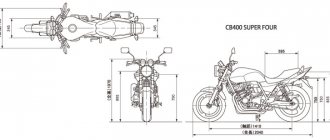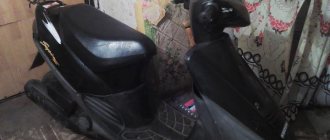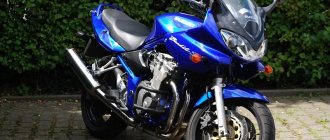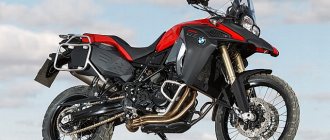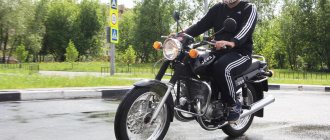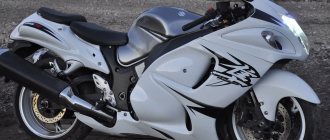Java motorcycles have enjoyed good popularity for a long time, because of the entire Java 350 line, the 638 was the most beloved model. Today, such Java can be found on the streets; it has a huge lifespan. The technical characteristics of the bike are quite good even today.
The motorcycle has been produced since 1985, and even then the model aroused great demand in the market. Java 638 boasted an excellent appearance, a powerful sports engine, a telescopic fork and a high-quality wiring system. Over the entire period of its life, both the engine and the appearance of the motorcycle have been modernized.
Pros:
- low fuel consumption;
- relative ease;
- classic design;
- good dynamics.
Minuses:
- at the present time, 2 bars will not be enough;
- spare parts for Java 638 are sometimes difficult to get even in online stores;
- too dangerous for beginners.
Technical characteristics of Java 538
At that time, Java 350 motorcycles were quite popular, because the work was carried out by a powerful 2-cylinder engine that operated in two-stroke mode. Today this is considered a thing of the past, because it will be much more powerful and cheaper to buy a bike with a four-stroke engine. But despite this, the technical characteristics of the Java 638 give it a good reputation and respect from the current generation.
Java operated on a manual gearbox at 4 speed, which ensured smooth running and gear shifting. Many complain that this is a real bike for craftsmen, because without riding skills you simply will not be able to curb its power. And here it is up to 26 horsepower. The declared volume of the Java engine is 638,343 cc. see. Unfortunately, in those days all motorcycles had only drum brakes; the disc system appeared only in 1994.
Refinement and tuning
Since the new Java 638 is very popular and the demand for this motorcycle does not subside, craftsmen continue to refine both the appearance of the motorcycle and its characteristics. On the Internet you can find many reviews and interesting technical solutions for tuning this motorcycle.
The change in appearance is sometimes so dramatic that it is difficult to believe that this motorcycle was once a classic java. The wheel rims are replaced with cast light alloy ones, the old front steering wheel fork is replaced with a more advanced, longer one, the seats and headlight are changed. There are simply no limits to the imagination of inventors.
To improve driving characteristics, drum brakes are replaced with higher quality disc brakes. To increase the service life of the engine, the bearing seats are changed, thereby improving their lubrication.
Previous post Java 350 – parameters and special properties of the legend
Next entry Technical characteristics of the Planet Izh 4 motorcycle
Review Java 350 638
This model is considered a continuation of the Java 350 634 motorcycle, the characteristics of which can be viewed at the link. The new model featured a more powerful engine and discreet design. In those years it was considered stylish and sporty, so in the 80s the Java 638 was the dream of thousands of people. The new product also differed from its younger brother in the absence of chrome in some parts. This could be explained by the fact that production was cheaper during release. Unfortunately, the 80s were a difficult period for the USSR, so they were unable to expand production and make the model as popular as the Java Old Woman, produced long before the 638 Java.
Current reviews of the Java 638 characterize the motorcycle as a true friend, which has a pleasant appearance, thoughtful details and, unfortunately, their absence on the market. The biggest disadvantage is the current shortage of parts for this model. There are more than enough motorcycle owners, but even finding Java 638 spare parts in an online store is sometimes difficult. Owners also consider spare parts too expensive.
Motor Java 359 638
Unlike other Java models, this new product had an important feature - the Java 638 cylinders were made of aluminum. Thanks to this innovation, the weight of the structure has been significantly reduced, and thanks to the aluminum fins, air cooling has become even better.
The manufacturer has placed great emphasis on the engine, so its characteristics are competitive even today. Unlike its predecessors, this vehicle has surpassed them in all respects in terms of engine performance. At a maximum speed of 5,500 rpm, it had a torque of 31.38 Nm. But having a 2-stroke system has its advantage - the engine has better distribution of exhaust gases, and the fuel mixture distribution system is now even simpler. Also, repairing a 4-stroke engine will be much more difficult. And most importantly, the maximum speed declared by the manufacturer was 120 km/h, but some owners talk about reaching 130 km/h.
Design Java 638
The most important change in the new product was the presence of a front telescopic fork, which its predecessors did not have. Thanks to this, the Java 638 fork allows you to withstand driving both on a flat track and on a road with difficult surfaces. The general appearance of the motorcycle was quite popular at that time - the absence of plastic, a long and voluminous muffler and the ability to reach any part. The seat on the Java 638 was quite comfortable, you could take one passenger.
The manufacturer also took care to change the location of the fuel tank, which, with a volume of 17 liters, received a special fastening. Thus, when driving fast, almost no vibration is heard from the tank.
History of appearance and description of the motorcycle
The motorcycle's history dates back to 1929, when Frantisek Janicek acquired a license for the production of two-wheeled vehicles from the Wanderer company. The first motorcycles were not very popular due to their high cost, complexity of design and operation.
During the occupation of Czechoslovakia, the factory stopped producing equipment altogether and was completely transferred to the needs of the German military department. The jawa 638, familiar in the Soviet Union, began production in 1984 and had a modification of the jawa 638 5 00. This model replaced the previous machine with the index 350-633. Here the driving and performance characteristics of the motorcycle have been thoroughly improved.
The appearance of the motorcycle, although not very outstanding, is nevertheless eye-catching. Among its other brethren, it is distinguished by elements characteristic only of Java: a large headlight and turn signals protruding from it, a harmoniously located instrument panel above the headlight, a large, neatly shaped tank and a double, straight seat.
There are compartments under the seat and on both sides of the tank for storing tools or belongings. The maximum speed that the Java 350 638 motorcycle can reach according to its passport is 130 km/h, but many enthusiasts tuning the Java 638 achieved much higher figures.
The Java 638 engine is air-cooled, and this fact also left its mark on the appearance of the motorcycle. The engine is completely open, with clearly visible structural elements. The engine also operates at higher speeds than all Soviet motorcycles produced at that time.
The Java 638 gearbox leg served as a kick starter. To do this, it was necessary to press it a little into the gearbox housing and lift it up. In the Soviet Union there was only one drawback for the owners of this motorcycle - the almost complete lack of spare parts and zip kits for repairs.
The motorcycle has proven itself remarkably well in motorsports. This bike was used in both speedway and stage racing. Motorcycles with sidecars were also used for racing.
Motorcycle Java 638 Lux
There are also two main modifications of the motorcycle - Lux and Super. They have an additional designation in the name - 000. Accordingly, the Lux modification received a special shock absorber, thanks to which it was possible to ride a motorcycle with a trailer. To make driving this version as comfortable as possible, the manufacturer installed rubber inserts for the knees and a new, more comfortable seat.
The exterior has also been improved, resulting in a different control panel and muffler. The cylinders on the Java Lux are now placed vertically, which saves space on the motorcycle.
Electrical equipment
The ignition of the YAVA 638 is no different from other, earlier models. However, the new battery with transparent walls allows you to provide the motorcycle with more voltage. This made it possible to install side reflectors and a rear light covering a larger viewing angle. In addition, there have been minor changes to the dashboard - more powerful light bulbs have been installed. The low power of the headlight reduces the load on the electrical wiring, which, in turn, provides additional safety. Previously, the grooves for wires were of original production, however, the YAVA 638 motorcycle was created according to world standards. Therefore, all plugs have the same input compared to other manufacturers.
Once upon a time (about 15 years ago) when we didn’t have the Internet yet, but the magazine “behind the wheel” sometimes pleased with articles about motorcycles. So in one issue of this publication that my father subscribed to, I saw it. What can I say then it was a dream ... And in the future, my father’s Izh Planet 5, which my parents bought after the collapse of the USSR so that they could ride it to the village. On it, under the strict guidance of my father, I learned all the intricacies of driving a motorcycle. And when I turned 16, I signed up for courses at the nearest driving school Category “A”, I took the exam in the winter, it was fun on the “Minsk” on the ice, even the traffic cop was smiling). And then, after a couple of years, they bought a Java 638 for my friend and we started riding together. The Java is of course a beauty, wherever I go and runs faster and runs smoother. But by that time I had already fallen in love with Izhachka, after all, it turned out to be a reliable motor that never seriously let me down , in general, we somehow became friends... And I began to be disappointed in Java, something was constantly wrong with my friend, and I had never met any normal Java at that time. My comrade eventually sold Java, and after reading magazines about Japanese motorcycles, I looked at my own, or rather my father’s Izh as a means of transportation and was already raving about the “Japanese”. But since I understood that this was simply not realistic, i.e. I can’t afford it. Gradually I put a big rusty nail into this whole motorcycle business and entered the institution. Everything changed after my wedding, one of my friends bought himself a cool bike, I went for a ride and also wanted to even go shopping, and there were prices... my wife, someone in Java rushed past us in the area, 5 minutes later he returned, it turned out to be a friend of whom I know, in general I liked his Java. And he had a 6-volt one converted to 12. And then I thought, not buy Is Java instead of great, the prices are almost the same! And newspapers and advertisements began, but everything was wrong, there were problems with the docks, and summer was already over. And then, digging through the Internet, I found an advertisement. Java with a real mileage of 9500 km. registered with 2006, before that it was in a box, and even in our city, but the price is too high! The money we had on hand was really not enough. If it weren’t for my wife, we wouldn’t have bought it! Thanks to her, she supported me, she said if you don’t buy it now, you won’t buy it never! She made me call, and I doubted that the seller would give up so much, because the Java is really worth it. In short, we bought it! We drove home through the whole city, but I didn’t believe myself, the Java is a “bomb”, I’ve never driven one like this in my life , everything is ideal except for the little things. And exactly the same as in the old magazine “Behind the Wheel”!!! Dreams come true...))) Not much on those parts: The first thing after purchasing was to replace the chain and rear ramp and after driving it a little, closed the season. By the 2010 season I installed a contactless electronic ignition, a fairing for the headlight, other mirrors, replaced the bearings in the front wheel, an air filter, lubricated everything that was possible and necessary, in 2011 a new battery, a front fender, cornering lights, a halogen headlight, well, it seems that’s it.
Additionally
— Stock engine power: 26 hp.
— Real engine power:
26 hp.
— Year of manufacture:
1993
— Date of purchase:
September, 2009
Appearance
The main changes affected the rear light. However, the design of the working parts has also changed. The front telescopic fork stands out more from the general background. The engine components have become more visible and closer to the exhaust system. The muffler itself has become a little longer and bulkier. Its increase increased the power of the unit. Moreover, the tank on the 85 model is fixed in a unique way, so vibrations are almost not transmitted to it.
In conclusion, I would like to say that the YAVA 638, whose fuel consumption is about 6-7 liters per 100 kilometers, is an ideal option for the rural population . The ability to transport passengers, off-road capability and transport cargo on an installed trailer makes it indispensable in the agricultural industry.




